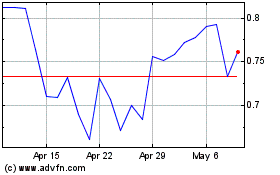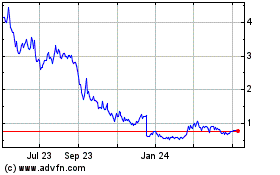Cara Therapeutics Announces Summary Data From Phase 1 Trial of Oral CR845 in Hemodialysis Patients with Chronic Kidney Diseas...
July 12 2017 - 7:00AM

Cara Therapeutics, Inc. (Nasdaq:CARA), a biopharmaceutical company
focused on developing and commercializing new chemical entities
designed to alleviate pain and pruritus by selectively targeting
peripheral kappa opioid receptors, today announced summary results
from its Phase 1 safety and pharmacokinetic trial of Oral CR845 in
chronic kidney disease (CKD) patients undergoing hemodialysis.
The Phase 1 results showed that all four tablet
strengths of Oral CR845 (0.25, 0.5, 1.0 and 2.5 mg) were generally
well-tolerated when administered either daily or after dialysis
three times per week. Top-line pharmacokinetic analysis indicated
that plasma levels of CR845 attained after oral administration of
doses up to 2.5 mg were comparable to or exceeded those attained
with clinically efficacious intravenous (I.V.) doses of CR845 for
the treatment of moderate-to-severe CKD-associated pruritus
(CKD-aP) in hemodialysis patients. The plasma levels of CR845
attained after oral administration of the 1.0 mg tablet strength
approximated those attained with the 1.0 mcg/kg I.V. CR845 dose,
which demonstrated significant clinical benefit in the recently
reported Phase 2/3 trial in hemodialysis patients with CKD-aP.
“We are pleased to establish that plasma levels
of CR845 attained with oral tablets equaled or exceeded plasma
levels previously associated with clinically efficacious I.V. CR845
doses in hemodialysis patients with moderate-to-severe
CKD-associated pruritus,” said
Frédérique Menzaghi, Ph.D., Vice President of
Research and Development at Cara Therapeutics. “These data will
inform the design of our planned Oral CR845 pruritus clinical
program in the non-dialysis CKD-aP population, which we aim to
initiate later this year.”
Phase 1 Trial Design and
Results
The Phase 1 trial was a three-part, randomized,
placebo-controlled study to evaluate the safety and
pharmacokinetics of Oral CR845 tablets in 90 hemodialysis patients.
In Part A, ascending repeated oral doses of 0.25, 0.5, 1.0 and 2.5
mg were given to four cohorts of patients (n=47) after each
dialysis (i.e., three times) over a one-week treatment period. In
Part B, ascending repeated oral doses of 0.25, 0.5 and 1.0 mg were
given daily to three cohorts of hemodialysis patients (n=36). In
Part C, the final crossover phase of the study, patients were
administered a single 1.0 mg oral dose of CR845 or a single 1.0
mcg/kg I.V. dose of CR845 (n=7) given after hemodialysis with a
one-week washout period between treatments to determine the
absolute bioavailability of Oral CR845. Parts A and B randomized up
to 12 patients per dose group (nine active and three placebo).
Part C was conducted as an open-label phase with seven patients
receiving active drug.
Overall, the frequency of treatment emergent
adverse events (TEAEs) in CR845-treated patients was similar to the
group administered placebo. All TEAEs were generally mild and
comparable to those reported in the Phase 2/3 trial after I.V.
CR845 administration in CKD-aP patients undergoing hemodialysis.
Absolute oral bioavailability of the 1.0 mg tablet strength was
determined to be similar in hemodialysis patients to that obtained
in non-CKD patients.
About CR845 for the Treatment of
CKD-associated Pruritus
The U.S. Food and Drug Administration (FDA) has
granted Breakthrough Therapy designation to I.V. CR845 for the
treatment of moderate-to-severe pruritus in CKD patients undergoing
hemodialysis. Breakthrough Therapy designation is granted to
expedite the development and review process for new therapies
addressing serious or life-threatening conditions, where
preliminary clinical evidence indicates that the drug candidate may
demonstrate substantial improvement over existing therapies on one
or more clinically significant endpoints. There are currently no
FDA-approved drugs for the treatment of CKD-aP.
About CKD-associated
Pruritus
CKD-aP is an intractable systemic itch condition
that occurs with the greatest frequency and intensity in CKD
patients undergoing hemodialysis and peritoneal dialysis; however,
pruritus has also been reported in CKD patients who are not yet on
dialysis. Aggregate, longitudinal, multi-country studies estimate
the weighted prevalence of CKD-aP to be approximately 50 percent of
patients with CKD stages 3-5 with approximately 25 percent of
patients reporting moderate-to-severe pruritus. This represents
approximately 4-5 million patients in the United States alone.
Similarly, the majority of dialysis patients (approximately 60-70
percent) report pruritus, with 30 to 40 percent reporting moderate
or severe pruritus. Recent data from the ITCH National Registry
Study showed that among those with pruritus, 59 percent had
experienced symptoms daily or nearly daily for more than a year.
Given its association with CKD/ESRD, most afflicted patients will
continue to have symptoms for months or years with currently
employed anti-pruritic treatments, such as anti-histamines and
corticosteroids, which are unable to provide consistent adequate
relief. Moderate-to-severe chronic pruritus has repeatedly been
shown to directly decrease quality of life, contribute to symptoms
that impair quality of life (such as poor sleep quality), and is
associated with depression. CKD-aP is also an independent predictor
of mortality among hemodialysis patients, mainly related to
increased risk of inflammation and infections.
About CR845
CR845 is a peripherally acting kappa opioid
receptor agonist currently in development for the treatment of
acute and chronic pain and pruritus. In more than 1,200 subjects
dosed to date either intravenously or orally, CR845 was observed to
be well-tolerated, without incurring the dysphoric and
psychotomimetic side effects that have been reported with centrally
acting (CNS-active) kappa opioid receptor agonists, and lacking the
respiratory depression and abuse liability of mu opioid receptor
agonists.
About Cara Therapeutics
Cara Therapeutics is a clinical-stage
biopharmaceutical company focused on developing and commercializing
new chemical entities designed to alleviate pain and pruritus by
selectively targeting peripheral kappa opioid receptors. Cara is
developing a novel and proprietary class of product candidates, led
by CR845, that target the body's peripheral nervous system and have
demonstrated initial efficacy in patients with moderate-to-severe
pain without inducing many of the undesirable side effects
typically associated with currently available pain
therapeutics.
Forward-looking Statements
Statements contained in this press release regarding matters
that are not historical facts are "forward-looking statements"
within the meaning of the Private Securities Litigation Reform Act
of 1995. Examples of these forward-looking statements include
statements concerning CR845’s potential to treat CKD-aP, the
establishment of the clinical utility of Oral CR845 and the future
clinical development of Oral CR845, including the expected timing
and design of any additional clinical trial(s). Because such
statements are subject to risks and uncertainties, actual results
may differ materially from those expressed or implied by such
forward-looking statements. Risks are described more fully in Cara
Therapeutics' filings with the Securities and Exchange Commission,
including the "Risk Factors" section of the Company's Annual Report
on Form 10-K for the year ended December 31, 2016, and its other
documents subsequently filed with or furnished to the Securities
and Exchange Commission. All forward-looking statements contained
in this press release speak only as of the date on which they were
made. Cara Therapeutics undertakes no obligation to update such
statements to reflect events that occur or circumstances that exist
after the date on which they were made.
MEDIA CONTACT:
Annie Starr
6 Degrees
973-415-8838
astarr@6degreespr.com
INVESTOR CONTACT:
Michael Schaffzin
Stern Investor Relations, Inc.
212-362-1200
michael@sternir.com
Cara Therapeutics (NASDAQ:CARA)
Historical Stock Chart
From Mar 2024 to Apr 2024

Cara Therapeutics (NASDAQ:CARA)
Historical Stock Chart
From Apr 2023 to Apr 2024
